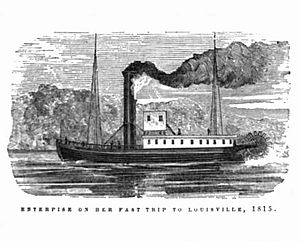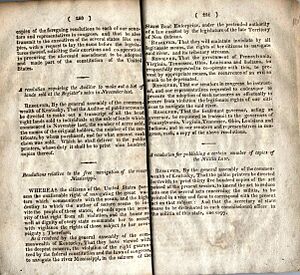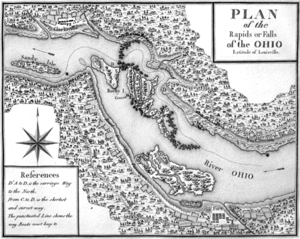Enterprise (1814) facts for kids

Enterprise on her fast trip to Louisville, 1815
|
|
Quick facts for kids History |
|
|---|---|
| Name | Enterprise, or Enterprize |
| Owner | Monongahela and Ohio Steam Boat Co., Brownsville, Pennsylvania |
| Builder | Daniel French designed and built the engine and powertrain. |
| Laid down | Fall, 1813 |
| Launched | May, 1814 |
| In service | June 7, 1814 |
| Out of service | After August 5, 1816 |
| Fate | Sank at Rock Harbor, Rock Island, Ohio River next to Shippingport, Kentucky. |
| Notes | The steamboat Enterprise demonstrated for the first time by her epic 2,200-mile voyage from New Orleans to Brownsville, Pennsylvania that steamboat commerce was practical on the Mississippi River and its tributaries. |
| General characteristics | |
| Length | 60–70 ft (18.3–21.3 m) |
| Beam | 15 ft (4.6 m) |
| Draft | 2.5 ft (0.8 m), light ship |
| Propulsion |
|
| Armament | Gun located on the bow for saluting |
The Enterprise steamboat made history with an amazing 2,200-mile (3,500 km) trip from New Orleans to Brownsville, Pennsylvania. This journey proved that steamboats could be used for trade and travel on the Mississippi River and its smaller rivers.
Contents
Early Journeys
The Enterprise, sometimes called Enterprize, was built in Brownsville, Pennsylvania. It was launched in May 1814 and had a special engine designed by Daniel French. Its owners were the Monongahela and Ohio Steam Boat Company.
The steamboat's first captain was Israel Gregg. The Enterprise carried people and goods between Brownsville and Louisville, Kentucky. From June to December 1814, it made two 600-mile (970 km) trips from Louisville to Pittsburgh. These trips went against the strong river currents. This showed for the first time that steamboats could be used for business on the Ohio River.
Voyage to New Orleans
In December 1814, General Andrew Jackson was in New Orleans. He was there to defend the city from a large British army. Jackson needed military supplies, especially guns and ammunition. The owners of the Enterprise decided to send the boat to help.
Henry Miller Shreve, an experienced captain from Brownsville, took command. He knew the Ohio and Mississippi Rivers well. On December 21, 1814, the Enterprise left Pittsburgh. It carried cannonballs, gun carriages, tools, and other military items. On January 9, 1815, the Enterprise arrived in New Orleans. It delivered the much-needed supplies.
Helping in the Battle of New Orleans
Normally, the Enterprise would not have been allowed in Louisiana. This was because Robert R. Livingston and Robert Fulton had a special right to control steamboat travel there. But General Andrew Jackson had declared martial law, which meant military rules were in charge. This protected the Enterprise from any problems.
Even with the supplies delivered, Jackson's forces still needed more guns and gunpowder. Jackson heard that other boats with supplies were near Natchez. He sent the Enterprise to find them. The Enterprise found the boats, towed them, and brought them to New Orleans.
The Enterprise then made another trip to Natchez. By February 12, 1815, it was back in New Orleans. It was listed in the New Orleans Wharf Register as "Steam Boat (le petit) Captne Shrive." After that, the Enterprise traveled up the Red River to Alexandria. It carried 250 soldiers before returning to New Orleans.
The Return Trip to Brownsville
On February 4, 1815, the British fleet left New Orleans. On February 16, the United States Senate officially ended the War of 1812 by approving the Treaty of Ghent. However, news of the peace treaty did not reach New Orleans until late February.
On March 1, Captain Shreve announced that the Enterprise would travel between Natchez and New Orleans. He planned for the boat to leave New Orleans for Louisville in early May. On March 13, General Andrew Jackson ended martial law.
On May 1, a man named John Livingston claimed that Captain Henry Shreve and the steamboat company had broken the law. He said they had violated the special steamboat rights given to Robert R. Livingston and Robert Fulton. John Livingston asked for $5,000 and for the Enterprise to be taken away. The sheriff quickly arrested Henry Shreve and seized the Enterprise. But on May 2, the company's lawyer, Abner L. Duncan, arranged for Shreve and the Enterprise to be released.
On May 6, Shreve and the Enterprise finally left New Orleans. After a 1,500-mile journey, they reached Louisville on May 31. The Enterprise was the first steamboat to travel from New Orleans to Louisville. It then continued to Pittsburgh and Brownsville. This entire trip, a distance of 2,200 miles (3,500 km) from New Orleans, was made against the strong currents of three major rivers. Newspapers across the western United States praised this important voyage.
Second Trip to New Orleans
In late 1815, Captain Lowns took over command of the Enterprise. He made trips to Ohio River ports between Pittsburgh and Louisville.
In November 1815, the Monongahela and Ohio Steam Boat Co. rented the Enterprise to James Tomlinson for $2,000. Tomlinson's son-in-law, Daniel Wehrley, became the new captain. The Enterprise arrived at Shippingport on January 21, 1816. On January 25, it left Shippingport with a full load of flour, whiskey, apples, and passengers, heading for New Orleans. The Enterprise reached New Orleans by February 27 and completed a roundtrip voyage by April 5.
The Enterprise Court Case
Another steamboat, the Dispatch, also owned by the Monongahela and Ohio Steam Boat Company, traveled to New Orleans. While it was docked, an incident happened. Robert Rogers, the first engineer, wrote about it:
"We arrived early in the spring, and soon after we landed at the Levee. Edward Livingston, together with the Marshall of the district, with some others came on board, and informed our captain that they (Fulton and Livingston) had the exclusive right to navigate the waters in Louisiana with steam-boats, granted to them by the Legislature of Louisiana and they did not allow their rights infringed; but as we plead ignorance of the law, they agreed if we would leave the State with our boat, and not return, they would not prosecute us. We then took in a little freight and a few passengers and started for Alexandria at the Rapids of the Red River, and after discharging our cargo, we returned to the mouth of the river; then took up the Mississippi for Pittsburg."
News of this event spread quickly. In January 1817, the Kentucky legislature passed a resolution because of the problems faced by the Enterprise and Dispatch.
The court case for the Enterprise took place in May 1816. Judge Dominic A. Hall was in charge. The company's lawyer, Abner L. Duncan, showed the court Daniel French's 1809 federal patent for his improved steamboat engine. Duncan argued that this federal patent protected everyone involved from the charges. On May 20, Judge Hall agreed. He said that the local government had gone too far in giving the steamboat monopoly. He dismissed the case against the Enterprise. This decision was big news and helped steamboat travel grow in the West.
Final Journey
After leaving New Orleans, the Enterprise, still under Captain Daniel Wehrley, reached Shippingport by August 5, 1816. The Ohio River above the Falls was too shallow to continue. So, the Enterprise was anchored safely in Rock Harbor.
A historian named Thomas Shourds learned about the final days of the Enterprise from Elisha Hunt, one of the company's main owners:
"The Enterprise finally reached Shippins Port, below the Falls of the Ohio river, and the river being low above, and freights dull, the Captain anchored the boat in deep water, and hiring two men to take care of her, went by land to Pittsburg. One of the men went ashore and the other neglected the pumps, the weather was hot, the seams of the boat opened, and the Enterprise filled and sank to the bottom, where, as Elisha Hunt, in a letter written in the year 1851, says 'she still is.' Elisha further states that while he was down in Kentucky, in 1818, a man offered him $1,000 for the wreck, as he thought he could get her engine out to run a saw mill."
In August or early autumn of 1816, the Enterprise "filled and sank to the bottom" while anchored in Rock Harbor. As Elisha Hunt said, "she still is."
Legacy of the Enterprise
The Enterprise left behind an important legacy:
- It showed that steamboat travel and trade were possible on the Mississippi River and its many branches.
- The court case involving the Enterprise helped stop monopolies from controlling steamboat travel. This opened up competition.
- The Enterprise was much cheaper to build, costing about $9,000 compared to $38,000 for the New Orleans.
- Because of its sternwheel design, the Enterprise could carry cargo by attaching a barge next to it. This meant the steamboat didn't waste time loading or unloading. It could also pick up or drop off cargo in places without regular docks.
These achievements helped steamboat commerce grow very quickly on America's western rivers.
Images for kids




